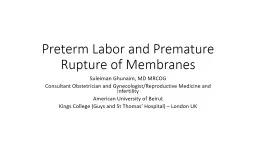

Suleiman Ghunaim MD MRCOG Consultant Obstetrician and GynecologistReproductive Medicine and Infertility American University of Beirut Kings College Guys and St Thomas Hospital London UK ID: 933080
Download Presentation The PPT/PDF document "Preterm Labor and Premature Rupture of M..." is the property of its rightful owner. Permission is granted to download and print the materials on this web site for personal, non-commercial use only, and to display it on your personal computer provided you do not modify the materials and that you retain all copyright notices contained in the materials. By downloading content from our website, you accept the terms of this agreement.
Slide1
Preterm Labor and Premature Rupture of Membranes
Suleiman
Ghunaim
, MD MRCOG
Consultant Obstetrician and Gynecologist/Reproductive Medicine and Infertility
American University of Beirut
Kings College (Guys and St Thomas’ Hospital) – London UK
Slide2Introduction
Preterm birth is the leading cause of neonatal morbidity and mortality in the world
7% of all births
Survival rates vary a lot between centers in the world
Most babies in the NICU are between 33-35
wks
simply because they have a better chance to live than younger babies but with higher morbidity especially respiratory problems
Slide3PROM vs PPROM
PROM is rupture of the membranes prior on onset of labor at term(20% of all cases presenting to the delivery room)
PPROM is rupture of membranes prior to onset of labor < 37
wks
(around 3-5% of all cases presenting to the delivery room)
The first thing to do is examine the patient in general and do a speculum exam, if pooling is seen then no need for further testing
If there is no pooling seen yet clinical suspicion of rupture do placental alpha macroglobulin -1 test (
Amniosure
) 99% efficient
DO NOT USE NITRAZINE LITMUS paper testing!!
Slide4PPROM
IF PPROM is diagnosed, then the first thing to do is to give latency antibiotics (oral erythromycin 250mg x4 daily) for a total of 10 days or until she is in labor
50% of patients with PPROM go into labor within the first week. If no labor, then switch the antibiotic to
Penecillin
-G until in labor or 37wks.
Serial testing for infection must be done (CBC, CRP, CTG for fetal status (daily)) every 1-2 days
Slide5Preterm Labor
Patient presents to the delivery room with regular painful contractions
Incidence is 5-7% of all
labours
presenting to the hospital
The first thing to do is a sterile speculum exam to see how dilated the cervix is ( DO NOT DO DIGITAL EXAM!)
Established preterm labor means that there are regular contractions (3-5 in 10 min each lasting for >40
secs
) with a cervical dilation of 4cm or more
Slide6Preterm labor
If there is suspicion of preterm labor and the patient is 30wks or more, then DO A CERVICAL LENGTH test by TVS
IF the cervical length is >15mm then discharge the patient home
IF the cervical length is < 15 mm then this is true preterm labor, then admit and manage
IF Cervical Length is unavailable, the do FETAL FIBRONECTIN test
If > 50 then this is Preterm labor, admit and manage, otherwise discharge home
Slide7How to manage Preterm labor
Tocolysis
: Start with
Nifidipine
in suspected preterm labor between 24 and 34
wks
of gestation , the second line agent to use is ATOSIBAN which is an oxytocin antagonist NOT USED FOR MORE THAN 48
hrs
!
Steroids: Give a single course (2 doses) of
Dexa
or Beta
methasone
between 24 and 34
wks
of gestation, you can CONSIDER steroids up until 37
wks
of gestation in cases of NVD or 39
wks
in cases of CS
MgSO4: Commence between 24-30
wks
and CONSIDER up to 34
wks
if there is imminent delivery
meaning suspected delivery within 24 hours
, needs monitoring for reflexes, respiration,O2 sat and so on Q2
hrs
Antibiotics: Use Oral or IV penicillin-G in any case of Preterm labor below 37wks to protect against Group B streptococcus infection (the main cause for neonatal sepsis)
Slide8How to monitor the baby
There is no evidence of fetal benefit from continuous CTG, intermittent fetal auscultation is advised
Fetal scalp electrode is Contraindicated below 34
wks
and relatively contraindicated below 37
wks
Fetal Scalp Blood sampling is Contraindicated below 34
wks
and relatively contraindicated below 37
wks
Slide9Our delivery target
Our target is always to deliver at 37 weeks
If we cannot achieve that or the patient goes into labor on her own then manage as per the previous slides
The American college of OBGYN recommends delivery between 34-37 weeks but the Royal college push towards 37
wks
Remember that MgSO4 cannot be used for more than 24 hours in each case of imminent delivery
The mode of delivery is always towards NVD except for Obstetrical indications then go for CS (Breech, Placenta
previa
, etc...)
Slide10Role of cervical Cerclage vs Progesterone in PTL
Hx
of preterm labor or fetal loss between 16 and 34
wks
and
a Cervical length incidentally found to be < 25mm done between 16 and 24
wks
THEN YOU CAN GO FOR EITHER VAGINAL PROGEST or CERVICAL CERCLAGE
If Incidentally found CL <25mm between 16 and 24
wks
--- GO FOR VAGINAL PROGESTERONE
IF PPROM in previous pregnancy or
Hx
of CERVICAL TRAUMA (cone biopsy)
and
Cervical length <25mm at 16-24
wks
gestation---- GO FOR CERCLAGE